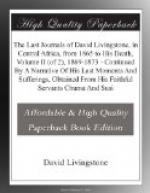28th October, 1872.—Left Kitanda, and came round the cape, going south. The cape furthest north bore north-north-west. We came to three villages and some large spreading trees, where we were invited by the headman to remain, as the next stage along the shore is long. Morilo islet is on the other or western side, at the crossing-place. The people brought in a leopard in great triumph. Its mouth and all its claws were bound with grass and bands of bark, as if to make it quite safe, and its tail was curled round: drumming and lullilooing in plenty.
The chief Mosirwa, or Kasamane, paid us a visit, and is preparing a present of food. One of his men was bitten by the leopard in the arm before he killed it. Molilo or Morilo islet is the crossing-place of Banyamwezi when bound for Casembe’s country, and is near to the Lofuko River, on the western shore of the Lake. The Lake is about twelve or fifteen miles broad, at latitude 7 deg. 52’ south. Tipo Tipo is ruling in Itawa, and bound a chief in chains, but loosed him on being requested to do so by Syde bin Ali. It takes about three hours to cross at Morilo.
29th October, 1872.—Crossed the Thembwa Rivulet, twenty feet broad and knee deep, and sleep on its eastern bank. Fine cold water over stony bottom. The mountains now close in on Tanganyika, so there is no path but one, over which luggage cannot be carried. The stage after this is six hours up hill before we come to water. This forced me to stop after only a short crooked march of two and a quarter hours. We are now on the confines of Fipa. The next march takes us into Burungu.
30th October, 1872.—The highest parts of the mountains are from 500 feet to 700 feet higher than the passes, say from 1300 feet to 1500 feet above the Lake. A very rough march to-day; one cow fell, and was disabled. The stones are collected in little heaps and rows, which shows that all these rough mountains were cultivated. We arrive at a village on the Lake shore. Kirila islet is about a quarter of a mile from the shore. The Megunda people cultivated these hills in former times. Thunder all the morning, and a few drops of rain fell. It will ease the men’s feet when it does fall. They call out earnestly for it, “Come, come with hail!” and prepare their huts for it.
31st October, 1872.—Through a long pass after we had climbed over Winelao. Came to an islet one and a half mile long, called Kapessa, and then into a long pass. The population of Megunda must have been prodigious, for all the stones have been cleared, and every available inch of soil cultivated.
The population are said to have been all swept away by the Matuta.
Going south we came to a very large arm of the Lake, with a village at the end of it in a stockade. This arm is seven or eight miles long and about two broad. We killed a cow to-day, and found peculiar flat worms in the substance of the liver, and some that were rounded.




